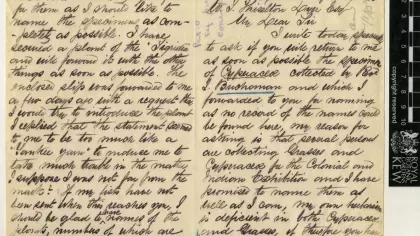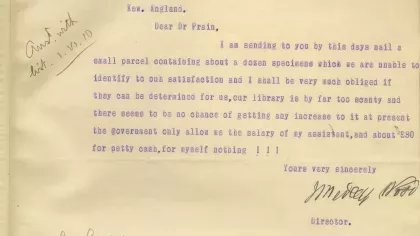Miscellaneous Reports Project
Enabling access through cataloguing and conservation to the Miscellaneous Reports Collection: an essential resource for exploring the central role of Kew in the colonial and global networks of economic botany and scientific activity, 1850-1928.

In the 19th and early 20th centuries, the transportation and cultivation of useful plants around the world was of critical importance to imperial Britain and its colonies across the world. From tea, coffee and tobacco to quinine and lime extract, plants were useful sources of food, medicine, clothing, and construction materials. Kew’s botanical expertise was consulted extensively as to the properties of different specimens, and the environments in which they could be successfully cultivated. Kew was also a central linchpin in coordinating the movement of seeds, plants, and botanists, across the expanding web of Botanic Gardens, Agricultural, and Forestry stations established by colonial administrations. Information flowed between Kew and a global network of botanists, colonial administrators, scientists and commercial interests.
The Miscellaneous Reports Collection is the resulting evidence of these interactions. The collection is made up of 772 volumes which are arranged geographically, and date primarily from 1850-1928. The collection covers a wide range of subjects, from sugar cane disease in Barbados to forests in Sudan, and silk worms in China. Within these volumes are correspondence, administrative and scientific reports, photographs, specimens, drawings, and maps, all of which resulted from Kew’s connection with this global network.
Cataloguing and research
The Miscellaneous Reports hold enormous potential for both historical and scientific research, furthering our understanding in the following areas:
- History and culture of Indigenous communities
- Economic botany
- British and World history: social, political and economic
- History of science
- Geography
In addition to the samples and specimens included in the Miscellaneous Reports, the collection contains important contextual information relating to Kew’s Herbarium and Economic Botany collections.
Until now, a significant barrier to accessing the collection has been the ‘miscellaneous’ nature of the material and its uncatalogued and physically inaccessible state. Many have titles such as ‘New Zealand Miscellaneous’, with no clue as to the varied topics covered inside. This has made the Reports locatable only by geographical area. During the Miscellaneous Reports Project the collection will be catalogued to file level, and will be made available on the online Kew Archives catalogue and shared through wider discovery platforms, the Archives Hub and The National Archives Discovery service. Indexing will create access points for subjects, places, people and plants, which will include innovative integration of Plants of the World Online with archive systems. This will enable researchers to follow the global movement of plants, people, and issues across the collection, and allow their diverse research potential to be realised.
Conservation
The Miscellaneous Reports contain a variety of material from early photographs, plans and drawings, to specimens, reports and news articles. This diversity has a direct impact on their conservation needs, and as a result of deterioration, many of the volumes cannot be accessed safely. An essential goal of the Miscellaneous Reports Project is the stabilisation and repair of these ‘at risk’ volumes, to further support access to the collection and preserve these records for the future.
Following a conservation survey, a strategy for repair has been developed in accordance with conservation and curatorial priorities. Information will be captured recording the type of binding, materials and method of construction, and will also document any structural changes to the volume. The treatments employed will utilise a range of techniques including rebacking, removal of pressure sensitive tape, stain reduction, paper repair and consolidation to ensure their safe ongoing use.
Objectives
- Increase access to the Miscellaneous Reports through cataloguing and indexing
- Ensure the collection can be accessed safely, and be preserved for present and future users
- Encourage engagement with the Collection and raise awareness of its potential to further our understanding of Kew’s relationships with indigenous communities, botanists and scientists, colonial administrators and trade networks
Project leader
Project manager
People
Wellcome Trust Research Resources Grant
- A catalogue for the Miscellaneous Reports freely available online
- Conservation work undertaken for the most at risk material
- Blog posts, displays and talks to increase awareness of the Collection
- A symposium on the Miscellaneous Reports to promote research engagement
The Botany, Trade and Empire: Exploring Kew’s Miscellaneous Reports Collection online conference took place in March 2021. Watch it back:
Follow the project’s progress on Twitter @Kew_LAA #MiscellaneousReports
Kew’s Archive catalogue can be accessed online
Access the online catalogue for the Miscellaneous Reports Collection

